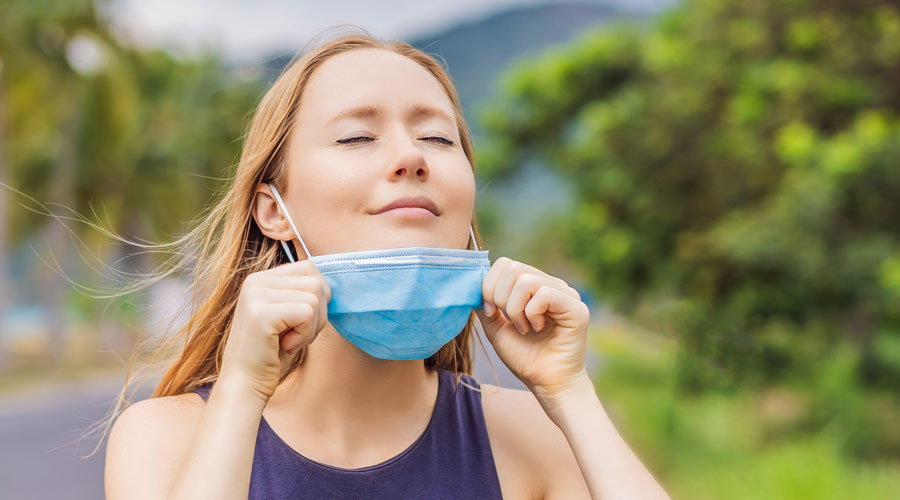Masks work best when everyone in the room is wearing one. That’s because when an infected person wears a mask, a large percentage of their exhaled infectious particles are trapped, stopping viral spread at the source. And when fewer viral particles are floating around the room, the masks others are wearing would likely block those that have escaped.
But there is also plenty of evidence showing that masks protect the wearer even when others around them are mask-free. The amount of protection depends on the quality of the mask and how well it fits. During a hotel outbreak in Switzerland, for instance, several employees and a guest who tested positive for the coronavirus were wearing only face shields (with no masks); those who wore masks were not infected. And a Tennessee study found that communities with mask mandates had lower hospitalisation rates than areas where masks weren’t required.
“Healthcare workers, scientists who work with nasty pathogens, and workers who may be exposed to hazardous airborne particles on the job rely on specialised masks such as N95s, so we know that properly fitted, high-efficiency masks work,” said Linsey Marr, a Virginia Tech [in the US] engineering professor and one of the world’s leading experts on viral transmission.
A number of laboratory studies have also documented that a mask protects the person who is wearing it, though the level of that protection can vary depending on the type of mask, the material it’s made from, the experimental setup and how particle exposure was measured.
But the bottom line of all the studies is that a mask reduces the potential exposure of the person wearing it.
Here are some of the findings.
One study from the Centers for Disease Control and Prevention found that a surgical mask protected the wearer from about 7.5 per cent of the particles generated by a simulated cough. But knotting the loops and tucking in the sides of the medical mask reduced exposure by nearly 65 per cent. Covering the surgical mask with a cloth mask, a technique known as double masking, reduced exposure to the simulated cough particles by 83 per cent.
A Virginia Tech study looked at how well homemade masks, surgical masks and face shields protected the wearer, based on particle size. The research showed that most masks could block very large particles, like those from a sneeze. But when the researchers looked at smaller aerosol particles that are hardest to block, protection ranged from near zero with a face shield to about 30 per cent protection with a surgical mask. Based on the findings, Dr Marr and her colleagues concluded that a two-layer cloth mask made of flexible, tightly-woven fabric, combined with a filter material (like a coffee filter or surgical mask), could offer good protection, reducing 70 per cent of the most penetrating particles and trapping 90 per cent or more of the larger particles.
A study from Tokyo tested how well different types of masks protected the wearer from actual coronavirus particles. It showed that even a simple cotton mask offered some protection (17 to 27 per cent). Medical masks performed better, including a surgical mask (47 to 50 per cent protection), a loose fitting N95 (57 to 86 per cent) and a tightly sealed N95 (79 to 90 per cent).
While many lab studies test masks using mannequin heads, a 2008 study used real people to measure how well masks could protect against a respiratory virus. The subjects wore different kinds of masks fitted with special receptors that could measure particle concentration on both sides of the masks. Cloth masks reduced exposure by 60 per cent, surgical masks by 76 per cent and N95 masks by 99 per cent.
While the lab studies show a mask can protect the wearer, how well the masks perform in the real world depends on a number of variables, including how consistently people use them, whether a person is in high-risk situations and the rate of infection.
The lab studies showed that a high-quality medical mask, like an N95, KN95 or KF94, works best. While vaccination is the best protection against Covid-19, even vaccinated people are advised to avoid crowds or large groups indoors when the vaccination status of others isn’t known.
Given that the Delta variant is far more contagious than other variants, Dr Marr also recommended wearing the highest-quality mask possible when you can’t keep your distance or be outdoors — or when nobody around you is masking up.
“If I’m in a situation where I have to rely solely on my mask for protection — unvaccinated people may be present, it’s crowded, I don’t know anything about the ventilation — I would wear the best mask in my wardrobe, which is an N95,” said Dr Marr. “Because Delta has proved to be so much more easily transmitted and because vaccinated people can transmit, we need to wear the best masks possible in high-risk situations.”
NYTNS











